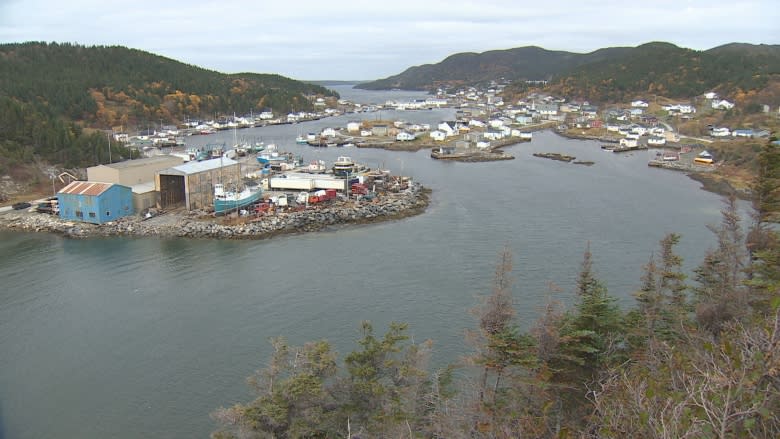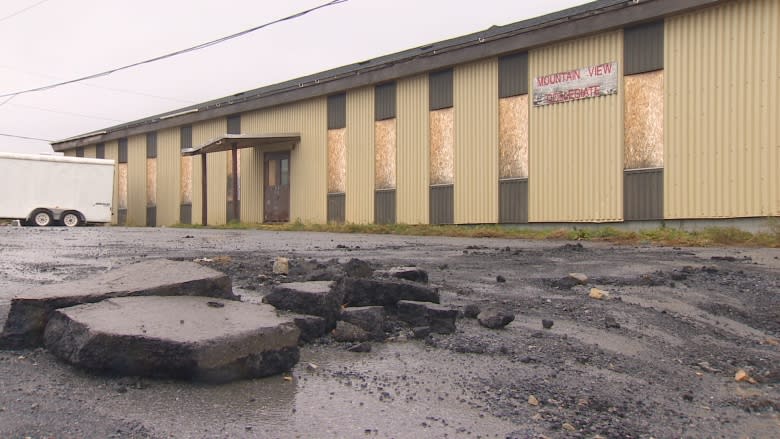'Just a ghost town, that's all': The Northern Peninsula and its population predicament
Hayward Elliott is 80 and hobbled by creaky knees, but that doesn't slow the soft-spoken man and his tool belt.
Holding a hammer in one hand and a strip of lumber in the other, he puts the finishing touches on some exterior repairs to the Anglican church in Cook's Harbour, a depleted and decaying fishing community on Newfoundland's Northern Peninsula.
A couple of new windows. Some siding.
Job done.
"She's in pretty good shape. We tries to keep it up best we can," Elliott says.
This church is a reflection of the community, the entire peninsula, and indeed much of rural Newfoundland and Labrador these days. Showing its age. Services attended by less than a dozen people. An 80-year-old man taking care of things, and absolutely no one to pick up the mantle — or in this case the hammer — when he's gone.
"She's going to go down. Same as everything else," Elliott says, surveying the 40-year-old house of prayer.
Wistful for bygone days
Welcome to Cook's Harbour, located at the extreme northern tip of the peninsula, about 50 kilometres northwest of St. Anthony, and 420 kilometres north of Deer Lake.
Population 76, according to the 2011 census, an astounding 60 per cent drop from the 2006 count.
At this rate, there won't be much left of Cook's Harbour — and many towns like it — in a decade or two.
Hayward Elliott is typical of the people you'll find here; In their twilight years, wistful for the days when the fishery was booming and children walked the streets in large numbers.
Now there are wharves crumbling into the ocean, fishing boats rotting on the beach, and most telling of all, about 20 vacant or abandoned homes.
The local all-grade school has just 11 students.
"Just a ghost town, that's all," Elliott says when asked what the town will look like in 20 years. "There'll be no one here."
It's a grim thing to say, but few would argue Elliott's opinion. And now it's backed up by research.
A recent report by Memorial University's Harris Centre paints a very troubling outlook for the Northern Peninsula.
Worst case scenario? A population plunge of more than 40 per cent over the next two decades. The estimated current population? Around 16,000.
Extinction not an exaggeration for some towns
Hardly surprising. The downward spiral started generations ago, and kicked into hyperdrive following the cod closure in 1992, when the population was about 25,000.
At this rate, the word extinction does not appear to be an exaggeration for some of the 70 communities that dot this vast peninsula. Most have tiny populations with very few school-aged children, and a noticeable absence of anyone in their 20s, 30s and 40s.
"The most we got here now is pensioners," says Jim Larkin, a Cook's Harbour businessman who's survived off the fishery for 30 years.
"If you take them out of the community right now you might have 20 people left here. So that will give you an idea how bad our community has been downgraded."
It's the same in Englee, an end-of-the-road town of about 500 on the eastern side of the Northern Peninsula.
In a span of a single generation, this town's population has been cut in half, and the worst may be yet to come.
"Our town is getting cleaned out fast," says Allen Compton.
Compton works on a fishing boat up north, earns big bucks, and is gone most of the year.
He says the only thing filling up in Englee is the cemetery.
"I think last year when I left, in around this surrounding area there was like nine or 10 people died. I was gone five months this year and I think there was another nine or 10 ... or 11."
A startling demographic structure
The worry is not just for small municipalities. Without a fresh injection of economic activity, regional service centres like St. Anthony also face a bleak future.
The town has been hit hard by cuts to government services, most notably the loss of the air ambulance and the closure of the marine communication and traffic services centre. The local hospital, once the administrative home for health care in the region, has also lost some of its influence.
Dozens of good paying, stable jobs — the kind that attract young professionals and their families — have disappeared.
And with no real thirst by most young people to work in the fishery, which offers seasonal work in a volatile industry, countless numbers of them have left.
St. Anthony's population — roughly 2,400 — has remained relatively steady, but the demographic structure is startling.
On one end of the spectrum, the number of school-aged children is at historic lows with just 16 Grade 1s at the new regional all-grade school.
A generation lost
On the other end, there's a different scenario.
At the modern shrimp processing plant St. Anthony, the youngest person on the processing line during a recent shift was 55 years old.
Sitting in his garage across the harbour, longtime community volunteer Dwayne Cull knows this is a big problem.
"The generation after us has moved away, by in large, along this coast, and in this community," says Cull.
Cull and his wife are like so many aging couples here. Empty nesters.
On a mature street like Lockes Cove Road in St. Anthony, many homes are occupied by a couple who keeps in touch with their children and grandchildren via online video links such as FaceTime or Skype.
Or, they spend weeks at a time visiting offspring who have dispersed far and wide, pursuing a future and planting roots in places like Deer Lake, St. John's, Fort McMurray.
Shaking up the social, economic foundation
It's part of a worldwide population shift from rural to urban centres, but here it's changing the social fabric.
Few are hopeful about the future, and it's playing on the minds of those left behind.
"When we go into the John M. Gray seniors home in 15 years time we're going to be very lonely," Cull adds.
"For my last years, unless I move out of here, I won't have a soul come and visit me."
Even the mayor finds it hard to be optimistic.
"I don't think there's any win. I think we're looking at a population decline that we've never seen before," says Ernest Simms.
"They often call this the forgotten coast. I think we'll truly see that come true."
Ask anyone here what the place will look like in 20 years, and they pause.
Like St. Anthony's Dwayne Cull, many figure they will stay for as long as they can enjoy the lifestyle they're used to.
"When it comes a point where I've got to sell my boat and sell the snowmobiles and give up fishing, then it's likely Dwayne will be moving on somewhere else," he says.








